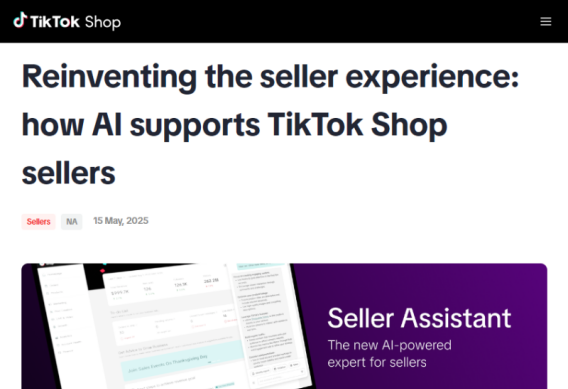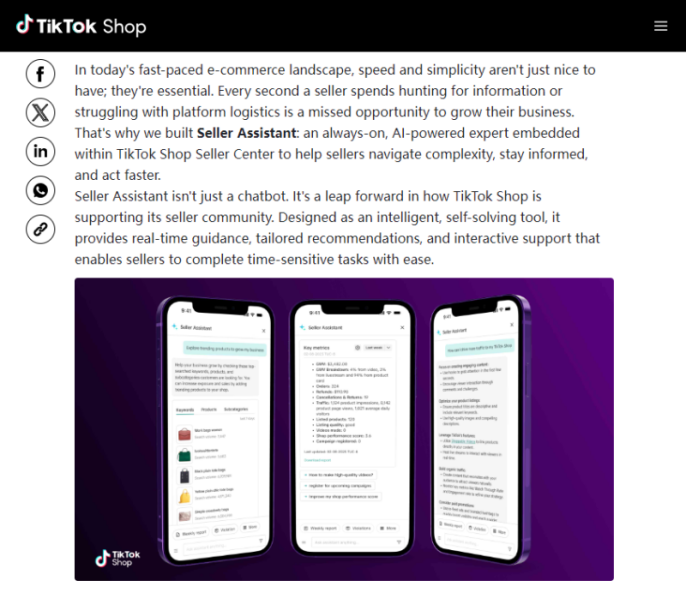ⅠTikTok launches AI-powered “Seller Assistant” tool
On May 23, TikTok announced the launch of an AI-powered “Seller Assistant” tool in its Seller Center, aimed at providing intelligent support to brands and merchants to optimize product management and marketing processes. The tool provides sellers with real-time operational recommendations, key data insights, and customized recommendations to enhance product visibility on the platform. TikTok stated that this assistant is part of its efforts to elevate the support capabilities for its e-commerce seller community, aiming to assist users in completing time-sensitive and complex tasks.

The Seller Assistant offers a range of features, including product listing strategy recommendations, tips for increasing visibility, data analysis support, and context-based marketing solution recommendations. The official description of the tool highlights its “smart self-service” capabilities, emphasizing its interactivity and contextual awareness.
Although the tool is essentially an AI chatbot, it holds significant potential for optimizing product listings and enhancing marketing efficiency. As TikTok continues to develop its in-app shopping ecosystem, the practical value of the Seller Assistant is expected to grow. Data shows that TikTok's platform sales tripled during last year's “Black Friday” period, with live-streaming sales performing particularly strongly.

Driven by both traffic growth and technological innovation, the Seller Assistant is seen as a key tool for TikTok's e-commerce business expansion. The feature is now officially available to all Seller Center users.
Ⅱ Southeast Asia's e-commerce market will exceed US$410 billion by 2030
According to the Southeast Asia 2025 report jointly released by DBS Bank and market intelligence company Cube Nextwave, Southeast Asia's e-commerce market size is expected to grow from US$184 billion in 2024 to over US$410 billion by 2030, more than doubling in size with a compound annual growth rate of 14%. Since 2012, e-commerce sales in the region have grown by 46 times, with platforms gaining widespread recognition as the primary shopping channel. The report notes that driven by market consolidation, increased platform fees, and a focus on core products, some key players have achieved profitability, and many companies are expanding into logistics and last-mile delivery services to enhance overall operational efficiency. As the industry matures, businesses are shifting their focus toward cost control, stable revenue, and customer retention, aiming to increase market share by offering more personalized and appealing experiences.
Ⅲ Lazada Cross-Border Unveils Five Business Strategies to Boost Merchant Growth
In the midst of the global digital revolution, Southeast Asia's e-commerce market is shining brightly, attracting widespread attention. According to the latest data released by Google and Temasek, the e-commerce market size of the six Southeast Asian countries is projected to reach US$375 billion by 2030. Behind this staggering figure lies immense potential and opportunities waiting to be tapped by cross-border merchants.
Although the e-commerce penetration rate in the six Southeast Asian countries is only 7%-11%, compared to China's high e-commerce penetration rate of 29%, the market development potential is vast, with a large number of consumers gradually shifting to online shopping. Additionally, as the economy develops, the number of middle-class individuals in the region is growing rapidly, positioning Southeast Asia as a new hub for middle-class expansion. According to a report released by World Data Lab in May, by 2035, cities such as Jakarta, Manila, Ho Chi Minh City, Bangkok, and Kuala Lumpur are expected to rank among the world's largest middle-class hubs. This indicates that the needs of Southeast Asian consumers are undergoing profound changes. They are no longer satisfied with low-priced goods but are beginning to seek products of higher quality and greater individuality, presenting valuable opportunities for cross-border merchants and brands to establish a strong presence and achieve long-term development.
As one of the most influential e-commerce platforms in Southeast Asia, Lazada has consistently dedicated itself to creating more business opportunities for merchants and helping them achieve success in the Southeast Asian market. At the 2025 Lazada & Daraz Business Development Conference in Shenzhen, Mango, Head of Cross-Border Platform Business at Lazada, unveiled the five core strategies for cross-border merchants to drive business growth, providing comprehensive and in-depth support to merchants to unlock their growth potential and jointly explore new market frontiers.
